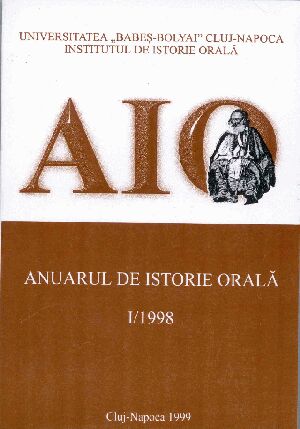COLECTIVIZAREA AGRICULTURII. STUDIU DE CAZ (LOCALITĂŢILE TEACA ŞI OCNIŢA, JUD. BISTRIŢA-NĂSĂUD). CERCETARE DE ISTORIE ORALĂ
THE AGRICULTURE COLECTIVIZATION. A CASE STUDY (TEACA AND OCNIŢA VILLAGES, BISTRIŢA NĂSĂUD DISTRICT). AN ORAL HISTORY RESEARCH
Author(s): Florin CioşanSubject(s): History
Published by: Argonaut
Summary/Abstract: The paper reveals the collectivization in two villages, Teaca and Ocniţa (Bistriţa). Our aim was not necessarily to remake the real process, but to reveal the villagers’ attitude towards the communist regime according to which agriculture had to be “collectivized”; for this reason we used as a reaserching method the interview. We also used traditional sources as press articles, archives, studies. The paper follows the evolution of collectivization in those two villages, taking into account the social and economic realities and also religious and ethnic points of view; it is also important their influence upon the methods used by authorities for the requirement of new structures; we had in mind the consequences upon the villagers. The study covers the years between 1949 and 1962, according a special view on the period between 1957-1962, when the villagers had a rough time. There are also signals for the first years after the Second World War in order to reveal the individual’s or collective attitude towards the communist regime. Our attempt used as a work-instrument the method of individual interview having a certain theme and some questions previously established; other questions are established according to each interview. We appealed to sixteen informers, taking into consideration religion, studies, gender, fortune and so on. After a short introduction regarding the settlement of the communist system in rural world, the study is taking into consideration the problem of collectivization from legislative point of view and also all consequences: shares, taxes, oppressive laws and so on. The paper continues with the stages of collectivization: associations, collective housekeeping etc. exactly how they were remined of by the villagers. According to the leaders’ strategies the methods used for villagers involvement in collectivization had the following steps: explaining, threat and beat or arrest in order to force somebody to join collectivization. Although the methods and strategies were the same in the two villages, the evolution of the colectivization was absolutely different. So, the signs of collectivization appeared first in Ocniţa then in Teaca due to ethnical, religious, social and economic points of view. Unlike Teaca, Ocniţa is a homogeneous village from the points of view mentioned formerly. That is why the villagers from Teaca are more vulnerable to collectivization that managed to convince some of the families from Teaca of its “utility”. Those from Ocniţa resisted to threat because of their solidarity; unfortunately they were forced by Miliţia and Security. The study comes to an end with a short analysis of the Oral sources used, taking into consideration the witnesses attitude toward the techniques (the interview), the quality of the memories according to studies, job, function in administrative structure and so on.
Journal: Anuarul Institutului de Istorie Orală
- Issue Year: 1999
- Issue No: I
- Page Range: 298-336
- Page Count: 39
- Language: Romanian

